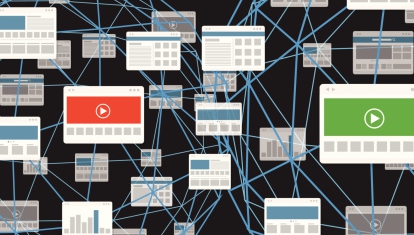marketing
What is Marketing Enablement? Definitions, Examples, and Why it’s So Important
There’s no shortage of buzzwords and jargon in the business world. But how do you know which are legitimate and which are passing fads?
Short answer: follow the money.
The total sales enablement marketing was worth $989 million in 2020 and is projected to climb to $3.1 billion by 2026.
Today’s consumer expects a custom-tailored, bespoke buying experience. They come into sales conversations armed with more knowledge than ever before.
We’ve written extensively on sales enablement, but this post will focus on an equally important, yet distinct term: marketing enablement.
We’ll go over:
- The differences between sales and marketing enablement.
- Best practices for implementing a marketing enablement strategy in your business.
- How a marketing enablement strategy can significantly boost revenue and customer engagement.
Let’s get started.
Sales enablement vs. Marketing Enablement: What’s the Difference?
Sales enablement is a term that gets thrown around a lot in business circles, but what does it actually mean? And what’s the difference between sales enablement and marketing enablement?
Sales enablement is all about giving sales teams the tools and information they need to sell more effectively. This can include things like product training, CRM systems, and marketing collateral.
Marketing enablement, on the other hand, is about giving marketing teams the tools and information they need to do their jobs more effectively. This can include things like market research, customer segmentation, automation software, and better lead generation tools.
In other words, sales enablement is focused on streamlining sales processes, while marketing enablement is focused on streamlining marketing processes.
Another good way to think about sales enablement is that it removes obstacles. We all have obstacles that prevent us from doing our core job responsibilities more effectively.
For sales, that may be rummaging through intranet folders to find the right piece of collateral. For marketing teams, it may be manual processes or analytics that could easily be automated.
Sales enablement and marketing enablement are all about removing those obstacles and eliminating as much day-to-day friction as possible.
Sales teams need information and tools that will help them close more deals, while marketing teams need information and tools that will help them generate more leads and build relationships with customers.

How Can Marketing Enablement Help My Business?
If you want to improve your sales performance, you need to invest in sales enablement. And if you want to improve your marketing performance, you need to invest in marketing enablement.
This is especially true in our rapidly-evolving, post-pandemic consumer economy.
The benefits of marketing enablement are many. It can help marketing teams become more agile and responsive, and better able to adapt to changes in the market. It can also help them become more efficient, freeing up time and resources that can be used on other tasks.
And perhaps most importantly, it can help marketing teams to better align their efforts with the overall business strategy.
Think about it: the less time spent on minutiae, the more time marketing teams can focus on high-level tasks that proactively move the business forward.
There are a lot of different statistics out there about the benefits of sales and marketing enablement, but here are a few of the most impressive:
- High-performing sales teams are 2.5 times more likely to have a dedicated sales enablement function than underperforming teams. (Bridge Group)
- 83% of companies say that sales and marketing alignment is critical to their success, but only 42% say they’re actually aligned. (HubSpot)
- 64% of salespeople say that access to the right content is critical to their success, but only 22% say they have the right content. (Forrester)
- Companies with strong sales enablement programs are 29% more likely to exceed their revenue goals. (CSO Insights)
As stated above, marketing enablement is about making sure that marketing teams have the tools and information they need to succeed. When done correctly, it can lead to increased sales, improved customer engagement, and better overall marketing performance.
What are some of the key tools and technologies used in marketing enablement?
Some of the key tools and technologies used in marketing enablement include marketing automation software, customer relationship management (CRM) systems, and content management systems (CMS). Additionally, many organizations invest in marketing enablement platforms, which provide a centralized location for all of their marketing resources and tools.
Marketing automation software is one of the key tools used in marketing enablement. This software helps organizations automate many of their marketing tasks, such as email marketing, lead management, and social media marketing. Additionally, marketing automation software can help you track the results of your marketing campaigns, allowing you to optimize your efforts for maximum ROI.
CRM systems are another key tool used in marketing enablement. CRM systems help organizations manage their customer data, including contact information, sales history, and marketing preferences. Additionally, CRM systems often include features such as lead tracking and scorecards, which can help marketing teams better understand their target customers.
Content management systems (CMS) are also often used in marketing enablement. A CMS helps organizations manage their website content, including blog posts, landing pages, and product information. Additionally, a CMS can be used to create and track marketing collateral, such as ebooks and whitepapers.
Many organizations also invest in marketing enablement platforms, such as Accent Technologies. These platforms provide a centralized location for all of an organization’s marketing resources and tools. Additionally, they often include features such as analytics and reporting, which can help organizations track the results of their marketing campaigns.
By investing in the right tools and technologies, you can ensure that your marketing enablement initiative is successful.
Marketing Enablement Examples and Best Practices
Now that we’ve gone over what marketing enablement is and how it can help your business, let’s take a look at a few examples of marketing enablement in action.
1. Free up time with automation
One of the biggest challenges for marketing teams is finding enough time to get everything done. There are only so many hours in the day, after all.
One way to free up time for marketing teams is to leverage automation. Getting started with automation doesn’t need to be difficult.
The first step is to document everything your team does. This includes:
- Internal processes and communications
- Marketing campaign execution
- Content production workflows
After a few weeks of documenting, you’ll likely have a treasure trove of ideas for automation. As a general rule, if you have to do something more than twice, it’s a great candidate for marketing automation.
There are a lot of different marketing automation tools out there. These platforms run the gamut from totally free to massive investments. Some of the most popular marketing automation tools are:
- Accent Technologies – a suite of marketing automation tools, including Accent Email for email marketing and Accent Social for social media management.
- ActiveCampaign – A comprehensive marketing automation platform that offers features like CRM integration, email marketing, and SMS marketing.
- Autopilot – A visual marketing automation tool that makes it easy to create and track customer journeys.
- HubSpot – a CRM and marketing automation platform.
- Marketo – a lead scoring and email marketing automation platform with enterprise-level features.
- Salesforce Pardot – a powerful marketing automation platform with features for sales intelligence and account-based marketing.
- Zapier – a robust service that links multiple applications together for custom automations.
2. Improve customer segmentation
Another way to improve marketing performance is to make sure that you’re targeting the right customers. This is where customer segmentation comes in.
Customer segmentation is the process of dividing your customers into groups based on shared characteristics. This can help you to better target your marketing efforts and improve your conversion rates.
There are many different ways to go about customer segmentation. Here are some to get you started:
- Create buyer personas – A buyer persona is a fictitious character that represents your ideal customer.
- Implement lead scoring – Lead scoring is a method of customer segmentation that uses a point system to rate leads based on their likelihood of becoming customers.
- RFM-based segmentation – RFM analysis is a method of customer segmentation that looks at three factors: Recency: How recently did the customer make a purchase? Frequency: How often do they make purchases? Monetary value: How much do they spend per purchase?
- Geolocation segmentation – Geolocation is a method of customer segmentation that uses location data to segment customers.
- Behavior-based segmentation – Behavior-based segmentation is a method of customer segmentation based on certain behavioral triggers. This type of segmentation can be used to segment customers based on purchase history, website activity, email engagement, or any other trackable metric.
- Firmographics segmentation – Firmographics is a method of customer segmentation that looks at company-level characteristics to segment customers. This type of segmentation can be used to segment customers based on company size, industry, and geography.
3. Use technology to better understand your customers
One of the best ways to improve your marketing enablement is to create more targeted content based on the above segmentations. This means creating content that’s specifically designed for for particular segments (and no one else).
The benefits of targeted content are many. It can help you to better engage your target audience, and it can also help you to improve your conversion rates.
Understanding your customers is one of the most fundamental aspects of a strong marketing enablement strategy. For more information, check out our post on how to use AI to better understand your customers.
4. Use marketing analytics
One of the best ways to improve your marketing performance is to use marketing analytics. Marketing analytics is the process of collecting, analyzing, and interpreting data about your marketing efforts.
This data can help you to understand what’s working and what’s not, and it can also help you to make better decisions about your marketing strategy.
This topic deserves a blog post all its own and is well beyond the scope of this article.
We’ve got you covered. Take a look at our guide to business analytics.
5. Streamline internal processes
One of the benefits of marketing enablement is that it can help to improve internal processes. When marketing teams have the tools and information they need, they can work more efficiently and effectively.
As part of your documentation process, be sure to document how your team communicates goals, structures campaign execution, and delivers content and critical information.
This is where a lot of marketing teams get hung up. They assume everyone is working off the same playbook when they’re not.
Automating and streamlining internal processes using tools like Zapier, Slack, and a dedicated marketing enablement platform will help cut down on necessary, yet tedious busy work.
Some more best practices for marketing enablement include:
- Defining clear objectives and metrics for success
- Creating a centralized repository for marketing assets
- Implementing a marketing automation system
- Building a strong team of marketing experts
- Leveraging data and analytics to drive decision making
How can you overcome these challenges and get the most out of marketing enablement?
There are a few things you can do to overcome these challenges and get the most out of marketing enablement.
First, make sure you have a clear and concise plan for how you’re going to implement marketing enablement. Second, make sure you have the full support of upper management (feel free to send them this blog post!).
And third, make sure you invest in training and support for your marketing teams.
By having a clear plan, getting buy-in from upper management, and investing in training and support, you can overcome these challenges and get the most out of marketing enablement.
How to hire and train marketing enablement specialists
When looking for someone to lead your marketing enablement initiatives, you should look for someone with:
- A deep understanding of marketing processes and best practices
- A strong understanding of technology and how it can be used to support marketing efforts
- Exceptional project management skills
- The ability to develop and implement training programs
- The ability to measure and track results
Once you’ve found the right person for the job, you’ll need to provide them with the necessary resources to be successful. This includes access to the right technology and tools, as well as dedicated time to develop and implement marketing enablement programs.
Choosing a marketing enablement platform
Marketing enablement platforms can help simplify and streamline your marketing efforts, saving you time and money. In addition, these platforms can help you better measure and track your marketing results, so you can fine-tune your strategy for maximum impact.
If you’re interested in exploring marketing enablement platforms, there are a few things you should keep in mind:
- It’s important to choose a platform that fits well with your existing marketing infrastructure.
- You’ll need to make sure the platform you choose offers the features and functionality you need.
- You’ll want to consider the cost of the platform and its ability to scale as your marketing needs grow.
Accent Technologies is the first and only SaaS company to bring together Sales AI and Content Management in a true REVENUE ENABLEMENT PLATFORM. We provide both sales and marketing with better visibility into the performance of their teams, as well as their effectiveness with their customers.
Through rich data analysis and intelligent recommendations for complex sales scenarios, the Accent platform empowers sales organizations to provide better coaching, forecasting, a more personalized buying experience, and stronger long-term customer support. Learn more about our solutions or request a LIVE DEMO to see it in action.
Final thoughts
Marketing enablement is a powerful tool that can help you achieve your marketing objectives.
When done correctly, marketing enablement can help marketing teams become more agile and responsive, better able to adapt to changes in the market, and more efficient in their work. Additionally, it can assist in aligning marketing efforts more closely with business strategy.
To make sure your marketing enablement initiative is successful, be sure to have a clear plan, set relevant goals, invest in the right technology and tools, create a culture of enablement, and have dedicated resources in place to support your efforts.











